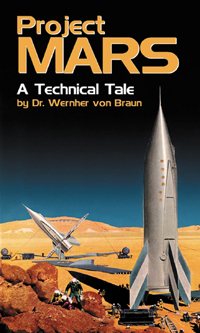$14.95 Canadian | Synopsis of Project Mars There are few dreams of the future which have woven so fascinating a web around human fantasy as flight through space. Since the first, epoch-making experiments of the great American pioneer of rocketry, Robert Goddard; since the days when Hermann Oberth, the German, and the Russian Constantin Eduardovitch Tsiolkowsky published their startling writings on rocket propulsion, a veritable spate of literature has overwhelmed the public. This has covered the entire field ranging from serious, scientific dissertations to comic strips. Putting the project in simple, narrative form permits me to outline the scientific, financial and organizational efforts which will be necessary before space travel can actually be brought into being. Few rocket enthusiasts have any idea of the inevitable scope or these efforts, nor are they mentioned in either scientific dissertations or in fiction. The space ship will, I am confident, never emerge full-fledged from the mind of any solitary inventor who has constructed it with the help of a faithful assistant in his back yard. Only by the joint effort of thousands of engineers and scientists in a wide variety of fields can it become a reality. The list of these fields is almost all-inclusive, extending as it does from astronomy through medicine, safety, radio, mathematics, chemistry, physics, aviation, metallurgy, production engineering, and a host of others. To back up the technical development there will be required farsighted industrialists, open-minded military men and daring financiers. Part of the object of this book is to stimulate interest in space travel throughout these and even wider circles, for many readers will discover that their professions or trades have hitherto unsuspected applications to it. Not a few such readers will find themselves filling in details at which I have here not more that hinted. Space travel’s prime objective in the minds of its serious protagonists is to benefit mankind by extending his sphere of activity. It is with some regret that such protagonists find that wherever large rockets are tested today, it is done with military objectives. But rocketry, like aviation and atomic energy, has enormous military significance aside from its more noble and constructive task. The stage setting for my narrative therefore is an Earth united after a final, global conflict in which are portrayed some of the terrifying aspects of future military rocketry. These aspects are inevitable concomitants of the finer phase, and I hope that they will not give offense. The military potentialities of the rocket are open to any technically-minded nation prepared to shoulder the burden of development. There’s no mystery about it: it involves mainly a scaling up of existing designs. As far back as 1912, it was possible accurately to compute the requirements as to size, fuel and horsepower for transatlantic aircraft. It was many years, however, before the development work to put them into service could be completed. It is therefore my desire that the reader should not remain ignorant of the tremendous impact on military science of the side field of rocketry. My most earnest hope is that the world may be spared another conflict, but if such a conflict should be inevitable, as appears at times, I want the homeland of my free choice, America, to hold the weapon of rocketry against her adversaries, whoever they may be. *** With the utmost care I have avoided delving into the realms of fantasy in describing physical conditions or phenomena encountered on the trip to Mars, nor have any assumptions based solely upon vague theories been used. No “miracle chest” from which the presiding genius produces at will “death rays” or “cosmic energy” will be found aboard my space ships. This is in contrast to so many science fiction stories which rely for their plausibility upon mysterious knowledge springing from the brains of some intellectual superman. My ships are propelled by compounds well known to the chemical fraternity. They are constructed of familiar materials; even their equipment is built up around presently familiar methods and procedures. In other words they are but a projection, an extrapolation, a natural development of a still youthful but solidly established technology. For like reasons, my space ships are not atomic-powered on their trip to Mars. In the face of the considerable quantities of propellants required for space travel when using chemical fuels, it has become a custom for many quasi-scientific writers to promise future atomic fuels which can do the trick better. The nature of these mysterious fuels is tacitly bypassed or conveniently cloaked by vague hints at “military security”. The controlling of nuclear energies is but a recent achievement in physics and technology. It may still conceal a number of future surprises and I have no desire, nor intention of decrying the eventual application of this source of power to navigation of interstellar space. When referring to technological advances, the word “impossible” must be used, if at all, with utmost caution… But I should like to state here, that within the framework of our present knowledge, atomic rocket fuels belong in the realm of wishful thinking. *** The second part of our story lands us on the reddish surface of our neighbour Mars, thus completing the technical mission. From this point on, the solid, scientific platform upon which we have stood sinks beneath our feet and we are tread upon the fairy bridge of fantasy via which, and via which alone, the author has visited Mars. In his reluctant attempt to portray the conditions which faced the crews of the space ships, he was reminded that the fine Italian hand of Dante apparently did not tremble when penning a most detailed description of the Inferno; and yet Dante probably had not nearly as much infernal scientific date upon which to base his descriptions as the author has Martian data. Encouraged by this classical precedent, the author swallowed his scruples and passed the “Point of no Return”. And so he has portrayed the Martians as age-weary from super-civilization, thus affording him the opportunity to speculate contemplative anent [about] the future of our own youthful, technology-ridden culture. For certain of our readers who may have gagged a bit on the mass of technical detail upon which they fed during he long voyage through space, this part of the story may offer opportunities for ruminative philosophical reflection
Paperback – 4” x 7” |

.jpg)
